Hey, kids! It’s Neopets story time! Finally! What have I been doing all this time? It’s a mystery.
Last time we talked about what a Plot actually was fundamentally because I like to be thorough, you know? So go check that out first if you haven’t! This round, we’ll talk about the Plot-making process, step by step.
A big caveat here is that each Plot was unique, so things didn’t always happen in this particular order, or even this linearly. Still, I hope this gives you an idea of what it took to get from concept to prizes for a Neopets Plot.
Oh, also, whenever I need a good example to illustrate a point, I’ll be using factoids from The Faeries’ Ruin because it’s the last full Plot our team did and also because I’m kinda super proud of it. ?
And, as always, the disclaimer: this is how we did things Back in My Day™. I have no idea how the current team works. They’re doing their own cool things in their own cool way and some or none or all of this may or may not apply. I have no idea. Take all this for what it is: how our particular team worked during our particular tenure.
Alrighty, off we goooo.
Step 1: Always Be Brainstormin’
This is a pretty simple but often underestimated part of Plot planning. I’ve read a lot of interesting assumptions over the years about about how this process went. Namely, that we’d go into a room and then come out of that room a few hours later with something like 75-80% of a Plot ready to go. HA, if only.
Rather, brainstorms were constant throughout the entire Plot. Figuring out what kind of Plot we wanted? Brainstorm. Story and character development? Brianstorm! Every puzzle/battle? BRAINSTORM. Point distribution and prizes? Brai—you get it.
Well, just in case: brainstorming was really important, okay.
Viola knows what’s up.
But this is labelled Step 1 so, let’s talk about that specifically. This is where we did the overall “what is it?” brainstorm(s) to figure out the basics. And of course those “basics” would be different pretty much every Plot. Maybe we already knew that we wanted to revamp a certain land (e.g. Tyrannia)? Then we’d start coming up with land-related storylines. Maybe we really wanted a War (Obelisk), so we’d come up with as many interesting conflicts as we could. Or maybe we had absolutely no idea of any direction at all (TFR), so we’d brainstorm what to brainstorm. Literally. We’d come up with hundreds of overall themes, inciting incidents, high-level story concepts, etc., and then vote on our favourites to start narrowing things down.
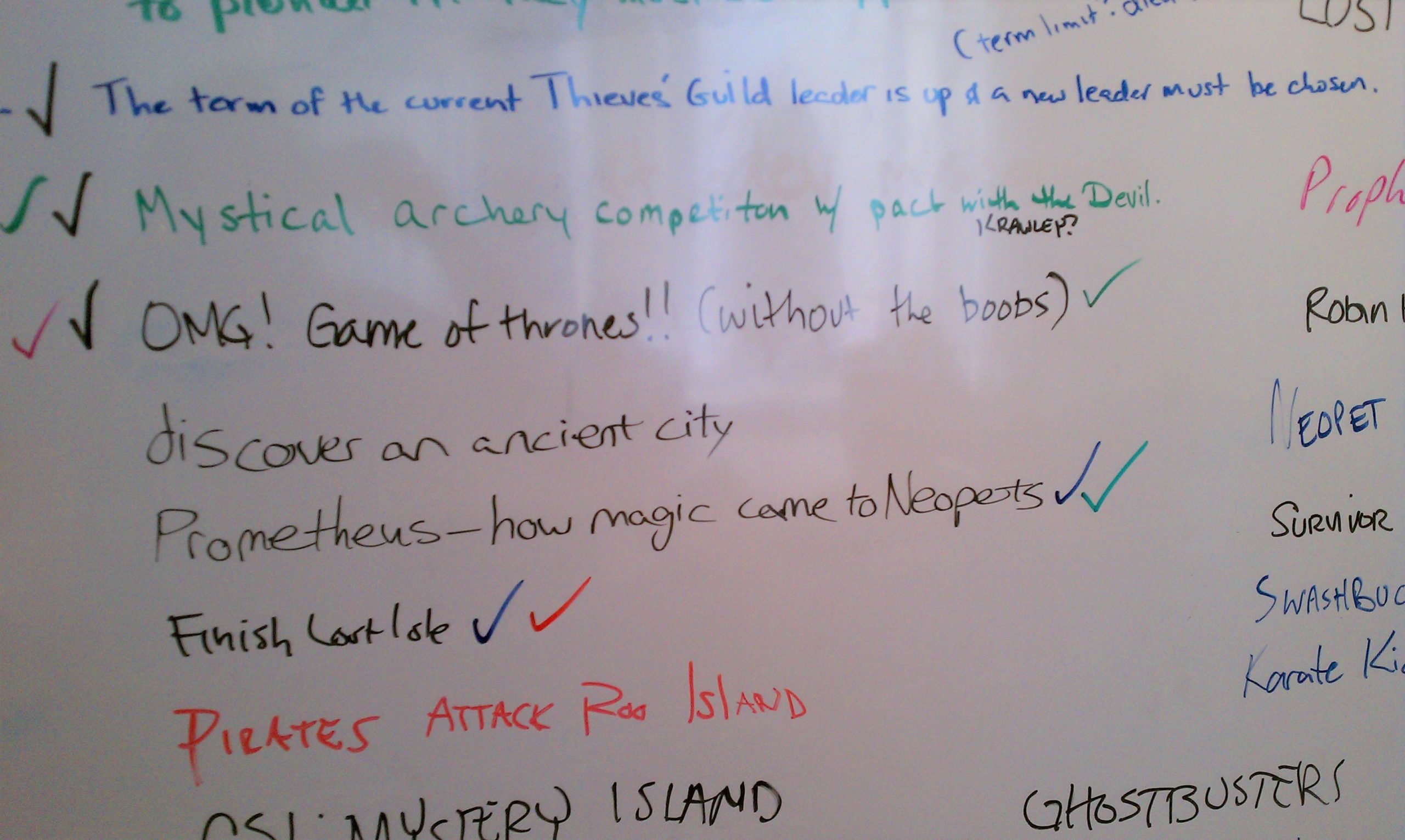
Everyone was invited to the early brainstorms (except on very rare occasions). The goal here was to get as many ideas as possible from different people with all different points of view, then go from there. Sometimes we’d just sit and talk to work through things or bounce ideas around but these larger brainstorms were much easier to keep organized using the white board and Post-its. Like so:
- If you had an idea, you’d write it down on a Post-it.
- You’d explain that idea in a bit more detail and discuss it with the group as you added it to the board. Everyone would take turns.
- When ideas slowed down or time was up, everyone went to the board to vote! You got X amount of checkmarks—usually a number made up by the Creative Lead running the meeting, based on how many ideas there were and/or what they were looking for, etc.—and you divided those checkmarks up among your favourite Post-its.
- (OPTIONAL) The Lead would find the things with the most votes and discuss them again with the group. Why folks had chosen those, what was specifically compelling about them, etc.
- (MANDATORY) JELLY BEANS.
The Creative Lead could then take these Post-its and get to work. That could mean scheduling another brainstorm to talk about a few of the top-voted ideas in more detail. Or narrowing it down on their own based on some criteria and scheduling another brainstorm to discuss that. Or writing a high-level outline (or several) to brainstorm in the next round. Or some combination. The point was to keep working at it with the group until we could move on to the next step.
And like I said, the brainstorms continued past this, getting smaller and smaller as the details were fleshed out more and more. (Eventually, they only included the main creative and production team members for that piece of the Plot, just for logistical reasons. 30 people in one puzzle brainstorm was not productive.) But this is how we usually started!
Damnit, Dirigibles.
Okay, anyway, on to the first “real” step of any Plot, where we actually feel like we start to progress…
Step 2: The Story
I say this a lot and will never stop: story drove everything. We might have known we wanted puzzles or a War or a world reveal or any number of logistical things but the story is what gave everything life, so that’s where we always began.
Another common misconception is that we’d jump right in and write the comics. NAY. We’d first
And that was after we changed the storyline completely. I’ll get to that in another post. Sorry for the tease.
Also, believe it or not, this made it much, MUCH easier to change things on the fly while the Plot was running if we needed to. (Spoiler: we always needed to.) We didn’t have to spend precious time researching things or
So, we’d start by writing everything out like you might a short story. It was just a Word document that anyone could read to understand the story we were trying to tell from start to finish.
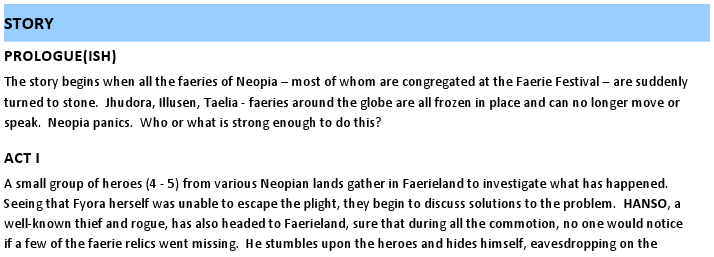
For my fellow story nerds, we generally followed the basic rules of a three-act structure and, at this point in the process, we weren’t yet worried about breaking it out for activities (though we’d make notes on such things). Our only concern was having a good overall story that was fun or sad or scary or interesting all on its own.
The Secondary Protagonist
We’d done many plots over the years, and one thing they usually had in common was a permanent change to Neopia in some way. They didn’t all have to! A good story with compelling characters is fun, too. But for the most part, we liked to think of Neopia as a second protagonist. If the world itself didn’t go through its own arc and change at the end of a Plot, big or small, then what was the point?
Plus, as a player, being able to say you remember Maraqua before the pirates or Faerieland before it crashed is super fun and gives you Neonerd cred.
So while it wasn’t required, we always looked for opportunities to do this with new Plot stories.
Plot Titles
We also gave plots titles (most of the time) because first and foremost we were telling a story. Every story has a title! This also made it easier to discuss, both when we spoke/messaged to the players and when the players talked amongst themselves.
That’s all I have to say about titles, really. This entire section is just an excuse for this tidbit:
Firstly, “plight” felt more temporary and implied an easily solvable situation, as opposed to the more dire and urgent danger that comes with “ruin”. A plight could maybe be rectified on their own or with a clear path to a solution but they would need the aid of a true hero overcoming great odds to prevent utter ruination.
Secondly, we realised “ruin” was secretly foreshadowing and would be a bit of a revelation later in the Plot. In the beginning, it was easy to think it referred to their stone state and having to undo that. Never in a million years did people think we’d actually turn Faerieland into ruins. *cackle*
So it turned out to be an easy choice after all!
Once we were satisfied (enough) with the story itself, we’d start working on actually telling it.
Step 3: The Comics
The first step of the comics was not to write the comics. I know; this is getting tiring. But I warned you this was a lot of work!
Oh, by the way, I say comics because that’s what we did most, but this really applies to any type of storytelling medium within a Plot, be it comics, animations, a literal book, or however else the story was told.
So first, we would do a full Plot outline based on the story doc to determine what went into each comic but also what went in between. Did I say we were satisfied with the narrative before? Yeah, no, it was still changing during this outline process. We’d move things around to make sure comic chapters ended in appropriate narrative spots, to better accommodate a puzzle or battle, and also just to make sure things were paced properly for a story told over such a long time span.
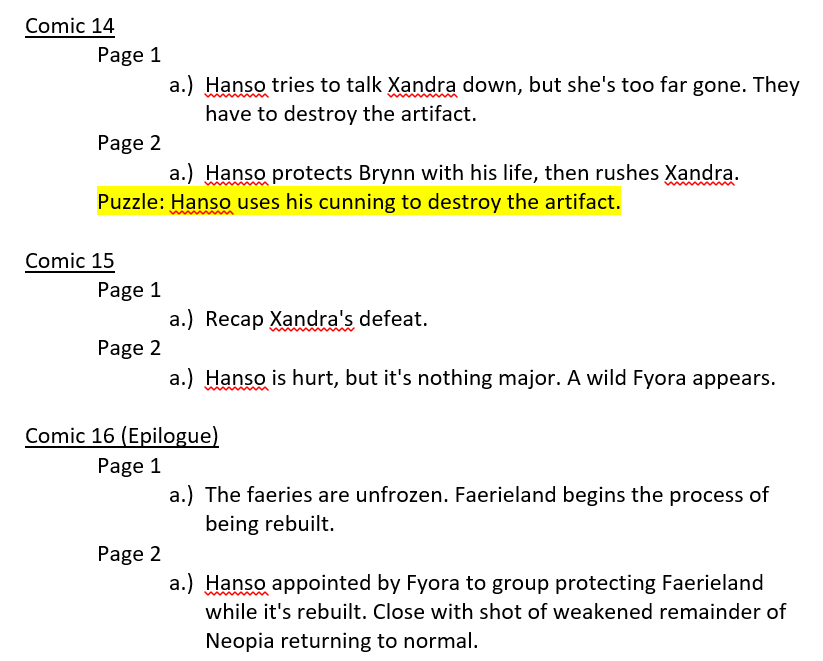
Now on to the comics. The scripts are written by the lead writer and the lead comic artist together. The writer could do it alone but it was always much better when the artist was involved to help with panel/page layouts. They’d send the draft around and the team edited it as a group to make it the best it could be. Our feedback often consisted of things like, “hahaha best line ever” and “he totally wouldn’t say that!” and “TOO MANY WORDS”. We are professionals.
I also want to note here that this process of pairing the lead writer and lead artist was my idea and resulted in a marriage later on so I am an awesome matchmaker nyah.
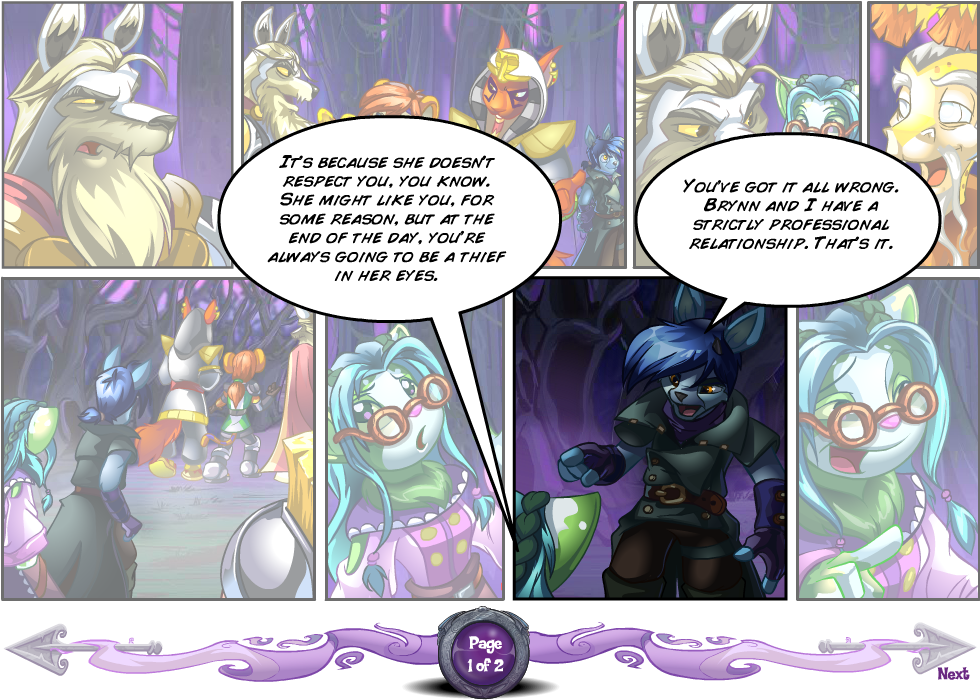
Anyway, once a script was done, then the art began. A comic page would be sketched out first—which also made the rounds for feedback—and then moved on to final colour.
And the entire Plot is still changing here. We find out things don’t work
Step 5: The Activities
Time to make you feel like a badass for solving a riddle or beating someone up! (Or for copying a guide on TDN.) We knew what type of activity we wanted thanks to the work done during the story and comics phases. Now we had to actually sit down and design it.
This was usually the Creative Lead and the Lead Programmer at a bare minimum, with others added depending on the activity. In the case of a puzzle, for example, anyone else who was good at them (or wanted to learn) could join. *cough* Dirigibles & Breik *cough* For battles, it might be writers or artists for NPC concepting and/or BD experts for tiering and difficulty, etc.
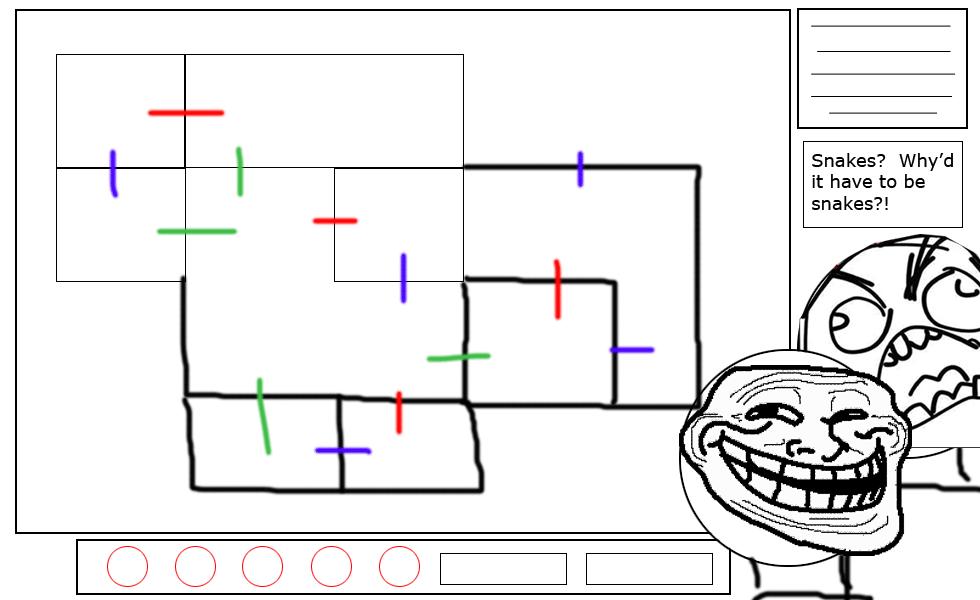
We’d start with the story motivation and then narrow down in on what the player was actually doing. Were they playing as a character in the story, or maybe themselves? What were they trying to accomplish? What type of activity fit the theme appropriately? What would be fun and could work within our tech limitations? Was it a good opportunity for a “multiplayer” activity? We’d determine steps, sketch out UI/UX, figure out activity rewards, etc. Lots of time spent together in small little rooms using up all our brain power. (No exaggeration, these really heavy puzzle brainstorm days were incredibly tiring. We’d be completely spent by the end of the day.)
Hey, I’d forgotten all about that! It was in the very first office when there were only 12 spots in the building’s parking lot and I had been lucky enough to pay for one of them that month. We walked down together just to finalize a couple small things on that puzzle but ended up brainstorming next to my hot pink Geo Tracker (which everyone affectionately referred to as the “Peptomobile”) for like 90 minutes. Things were different back then.
And remember: this is all going on in tandem with the rest. Chapter 5 might be getting drawn while Chapter 6 is being written and Chapter 7 is in outline stage and the puzzle in between 4 and 5 is being brainstormed. I think they call this “spinning plates”.
Step 6: The Rewards
Sadly, every Plot had to end… except we still had quite a bit of work to do.
Points
Plot points were always determined afterwards because we never knew how many people would participate, how easy or difficult a particular step would end up being, how much time people would dedicate, etc. So things were always tallied at the end where we could figure out the average completionists and the top completionists.
Average completion was usually putting in the effort to keep up as each step was revealed plus complete the extra achievements, though sometimes it was minus achievements. (Again, depends on the Plot and what most players were able to accomplish.) And top tier was going way above and beyond that, be it based on time or repeatable steps or what have you, because y’all crazy. Then we could work around those two sets for points and tiers.
So we essentially graded on a curve… ish. We wanted to make sure average completionists could get the top tier prize—if you wanted it because CHOICE—plus some simple souvenirs. How much you could afford after that was based on how much extra you were able to do compared to your fellow Plot-goers.
ANYWAY, this meant a LOT of querying a bunch of different databases and doing a ton of math to figure out which other databases needed querying and math needed doing, then deciding we needed a better spread here or a different algorithm there. The Lead programmer would do a bunch of work to get data, we’d discuss, they’d go back to get more data, and repeat until we thought things were fair and people were properly rewarded for their efforts.
Prizes
We never finalized prizes until the end either, which seems to surprise people as well! The prize brainstorm list didn’t start until the first chapter was released. That way we could note people’s reactions as the Plot was happening and maybe turn the memes and jokes into souvenirs.
Side Note: This was actually just a version of a process we did for every event or piece of content, where we’d go collect feedback and compile it to send around to everyone on the team. Quotes from the boards or fansites and such helped us figure out what was working and what wasn’t so we could improve they way we did things in the future. During Plots, a lot of replies to that email would be, “That should be a prize!”
Then, once the Plot was over and we had a big list of everyone’s favourite moments and memories down as prize ideas, we’d brainstorm our own and end up with a giant list. And, you guessed it, we’d get in a room to discuss and narrow that down to the final set of prizes.
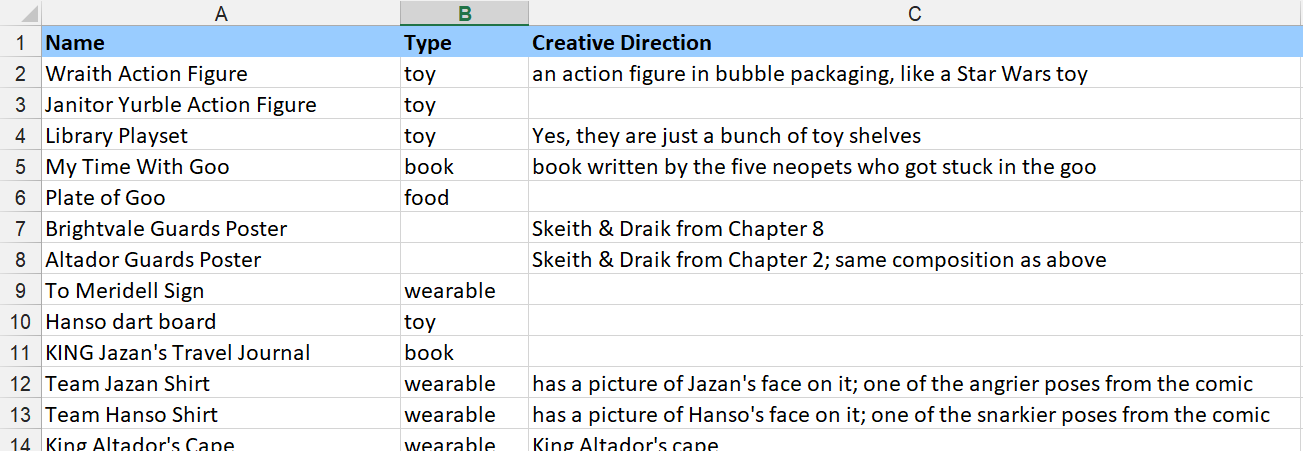
And then we’d have to make those art requests and the artists needed time to create them. Since they could be simple 80×80 images or full blown wearables that needed to be drawn for every species (not to mention functional items that needed scripting), this took a while. So you weren’t just waiting on us number crunchers for prizes!
But no, you were. It was mostly us. Sorry about that.
Whew.
As I said in the previous post, this whole process took months. The story step alone was a long process full of brainstorming and writing and re-writing and throwing it away and starting over and doing it all again. Writing a comic chapter could take a couple weeks, and then took another three to four weeks to be drawn. Etc., etc.
Some specific examples? Tale of Woe, which already had story work done on it for the TCG expansion, was about three months from start to launch day. TFR was about five months to launch day, since we started that story from scratch.
And I say “to launch day” because we didn’t finish all of these steps, for every chapter and activity, before the Plot actually launched on the site. HA HA HA NO. We got as far ahead as we could with the months we had prior to launch and then continued working on future parts (using feedback we were getting on the fly for launched parts to help inform decisions) while simultaneously launching, keeping an eye on, and modifying finished parts along the way.
Masochists, all of us.
Next Time…
I hope that was informative! I never know, writing into the void, but it’s fun regardless.
Next up, I’ll talk specifically about The Faerie’s Ruin since that’s last one we did and seemingly a big favourite (definitely mine). I’ll share some deeper story notes, character concepts, etc…. as long as I can find those images/docs again, that is. Yeah. I should do that.
So look out for that if you’re a fan of that Plot in particular! Hopefully I get to it faster than I did this. Anyone want to take bets?
See you then.

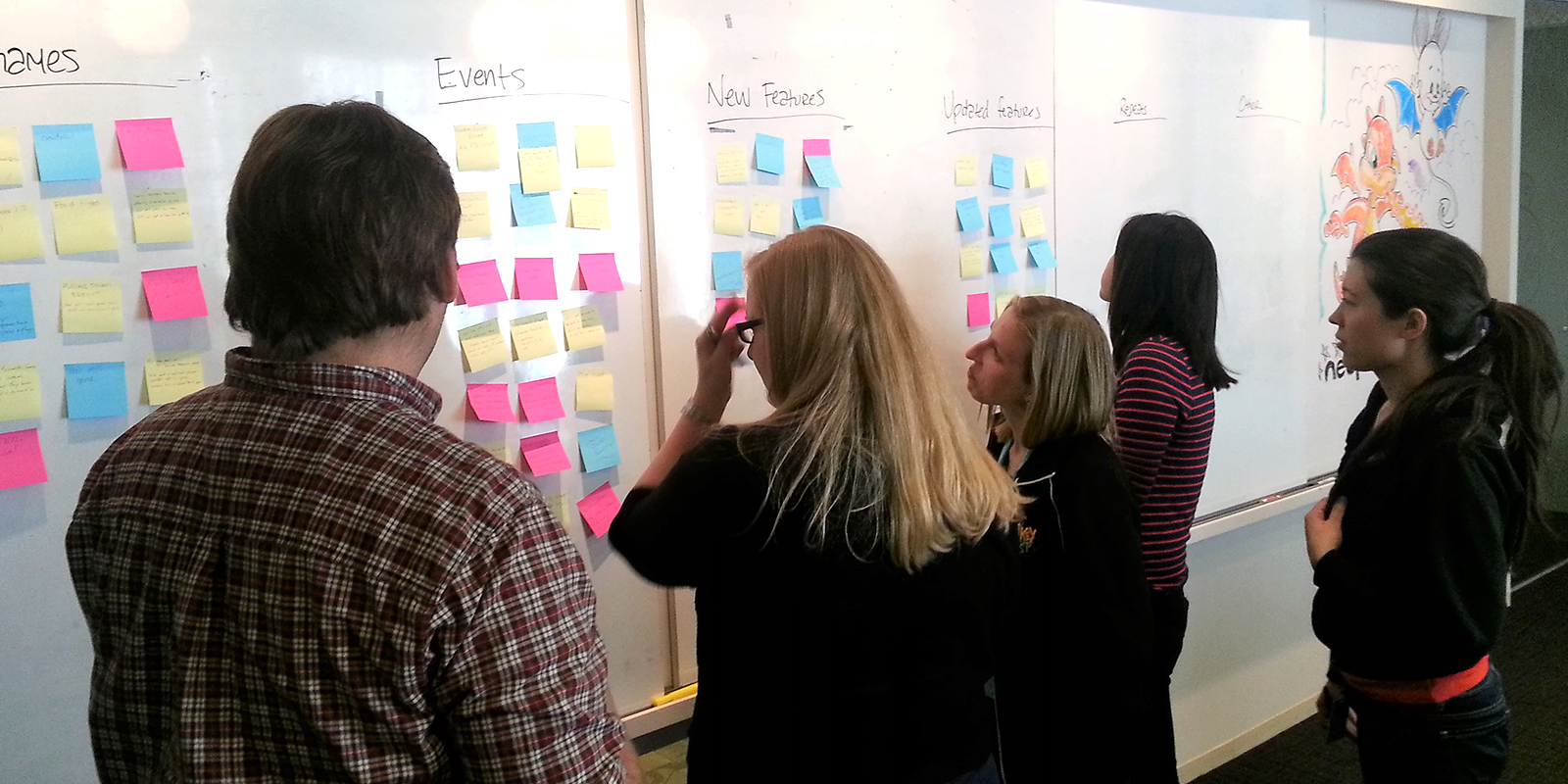
This is all so fascinating to learn about, thanks for sharing! Particularly as The Faeries’ Ruin was such a groundbreaking and unexpected plot – truly world-changing. I’m eagerly awaiting the next instalment 🙂
All the time and effort put into the Neopets lore and plots is amazing
I’m really curious, what was behind the decision to make the altador plot a permanent plot and all of the others one offs?